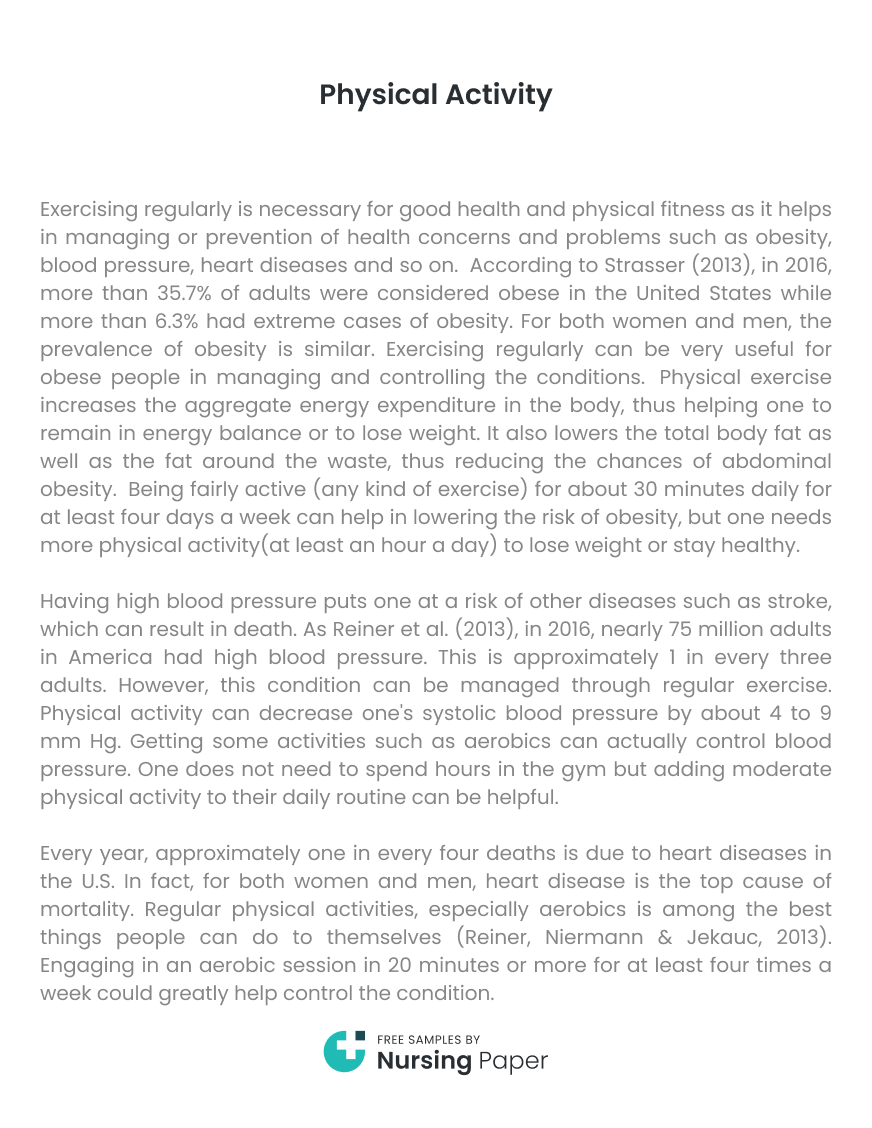
Physical Activity
Introduction
Exercising regularly is necessary for good health and physical fitness as it helps in managing or prevention of health concerns and problems such as obesity, blood pressure, heart diseases and so on. According to Strasser (2013), in 2016, more than 35.7% of adults were considered obese in the United States while more than 6.3% had extreme cases of obesity. For both women and men, the prevalence of obesity is similar. Exercising regularly can be very useful for obese people in managing and controlling the conditions. Physical exercise increases the aggregate energy expenditure in the body, thus helping one to remain in energy balance or to lose weight. It also lowers the total body fat as well as the fat around the waste, thus reducing the chances of abdominal obesity. Being fairly active (any kind of exercise) for about 30 minutes daily for at least four days a week can help in lowering the risk of obesity, but one needs more physical activity(at least an hour a day) to lose weight or stay healthy.
Having high blood pressure puts one at a risk of other diseases such as stroke, which can result in death. As Reiner et al. (2013), in 2016, nearly 75 million adults in America had high blood pressure. This is approximately 1 in every three adults. However, this condition can be managed through regular exercise. Physical activity can decrease one’s systolic blood pressure by about 4 to 9 mm Hg. Getting some activities such as aerobics can actually control blood pressure. One does not need to spend hours in the gym but adding moderate physical activity to their daily routine can be helpful.


Coclusion
Every year, approximately one in every four deaths is due to heart diseases in the U.S. In fact, for both women and men, heart disease is the top cause of mortality. Regular physical activities, especially aerobics is among the best things people can do to themselves (Reiner, Niermann & Jekauc, 2013). Engaging in an aerobic session in 20 minutes or more for at least four times a week could greatly help control the condition.
1. Reiner, M., Niermann, C., Jekauc, D., & Woll, A. (2013). Long-term health benefits of physical activity–a systematic review of longitudinal studies. BMC public health, 13(1), 813.
2. Strasser, B. (2013). Physical activity in obesity and metabolic syndrome. Annals of the New York Academy of Sciences, 1281(1), 141-159.



The download will start shortly.

The download will start shortly.
 Subject:
Health and Social Care
Subject:
Health and Social Care  Number of pages: 3
Number of pages: 3  Subject:
Health and Social Care
Subject:
Health and Social Care  Number of pages: 3
Number of pages: 3  Subject:
Health and Social Care
Subject:
Health and Social Care  Number of pages: 4
Number of pages: 4  Subject:
Health and Social Care
Subject:
Health and Social Care  Number of pages: 3
Number of pages: 3  Subject:
Health and Social Care
Subject:
Health and Social Care  Number of pages: 2
Number of pages: 2  Subject:
Medicine
Subject:
Medicine  Number of pages: 2
Number of pages: 2  Subject:
Health and Social Care
Subject:
Health and Social Care  Number of pages: 2
Number of pages: 2  Subject:
Health and Social Care
Subject:
Health and Social Care  Number of pages: 4
Number of pages: 4  Subject:
Medicine
Subject:
Medicine  Number of pages: 2
Number of pages: 2  Subject:
Health and Social Care
Subject:
Health and Social Care  Number of pages: 9
Number of pages: 9  Subject:
Medicine
Subject:
Medicine  Number of pages: 7
Number of pages: 7  Subject:
Health and Social Care
Subject:
Health and Social Care  Number of pages: 2
Number of pages: 2  Subject:
Medicine
Subject:
Medicine  Number of pages: 3
Number of pages: 3  Subject:
Health and Social Care
Subject:
Health and Social Care  Number of pages: 4
Number of pages: 4  Subject:
Health and Social Care
Subject:
Health and Social Care  Number of pages: 2
Number of pages: 2 
